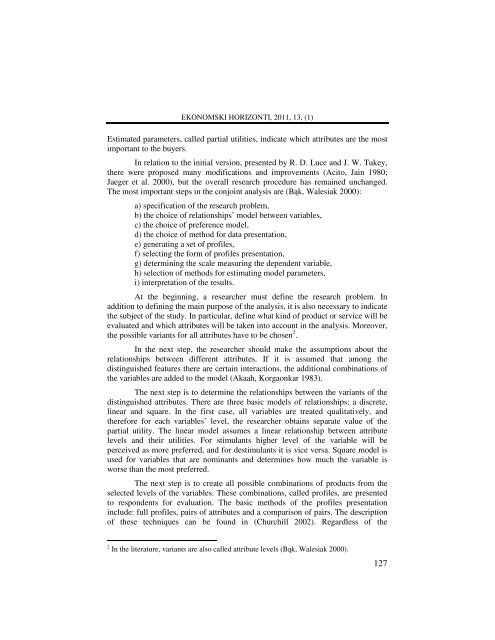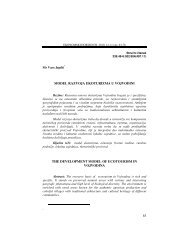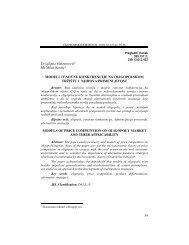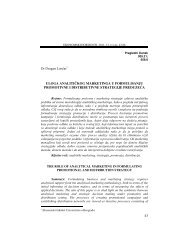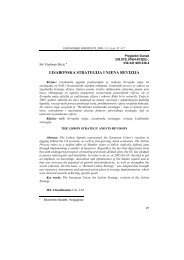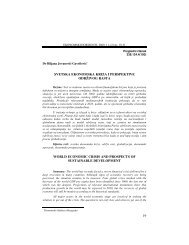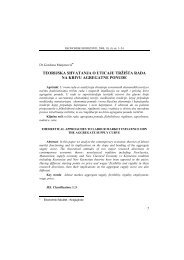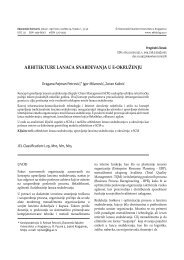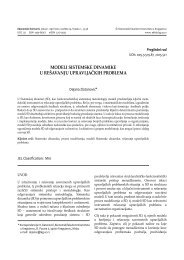yu issn 1450-863 x godina xiii broj 1 / 2011. - horizonti.ekfak.kg.ac.rs
yu issn 1450-863 x godina xiii broj 1 / 2011. - horizonti.ekfak.kg.ac.rs
yu issn 1450-863 x godina xiii broj 1 / 2011. - horizonti.ekfak.kg.ac.rs
You also want an ePaper? Increase the reach of your titles
YUMPU automatically turns print PDFs into web optimized ePapers that Google loves.
EKONOMSKI HORIZONTI, 2011, 13, (1)<br />
Estimated paramete<strong>rs</strong>, called partial utilities, indicate which attributes are the most<br />
important to the buye<strong>rs</strong>.<br />
In relation to the initial ve<strong>rs</strong>ion, presented by R. D. Luce and J. W. Tukey,<br />
there were proposed many modifications and improvements (Acito, Jain 1980;<br />
Jaeger et al. 2000), but the overall research procedure has remained unchanged.<br />
The most important steps in the conjoint analysis are (Bąk, Walesiak 2000):<br />
a) specification of the research problem,<br />
b) the choice of relationships’ model between variables,<br />
c) the choice of preference model,<br />
d) the choice of method for data presentation,<br />
e) generating a set of profiles,<br />
f) selecting the form of profiles presentation,<br />
g) determining the scale measuring the dependent variable,<br />
h) selection of methods for estimating model paramete<strong>rs</strong>,<br />
i) interpretation of the results.<br />
At the beginning, a researcher must define the research problem. In<br />
addition to defining the main purpose of the analysis, it is also necessary to indicate<br />
the subject of the study. In particular, define what kind of product or service will be<br />
evaluated and which attributes will be taken into <strong>ac</strong>count in the analysis. Moreover,<br />
the possible variants for all attributes have to be chosen 2 .<br />
In the next step, the researcher should make the assumptions about the<br />
relationships between different attributes. If it is assumed that among the<br />
distinguished features there are certain inter<strong>ac</strong>tions, the additional combinations of<br />
the variables are added to the model (Akaah, Korgaonkar 1983).<br />
The next step is to determine the relationships between the variants of the<br />
distinguished attributes. There are three basic models of relationships: a discrete,<br />
linear and square. In the fi<strong>rs</strong>t case, all variables are treated qualitatively, and<br />
therefore for e<strong>ac</strong>h variables’ level, the researcher obtains separate value of the<br />
partial utility. The linear model assumes a linear relationship between attribute<br />
levels and their utilities. For stimulants higher level of the variable will be<br />
perceived as more preferred, and for destimulants it is vice ve<strong>rs</strong>a. Square model is<br />
used for variables that are nominants and determines how much the variable is<br />
wo<strong>rs</strong>e than the most preferred.<br />
The next step is to create all possible combinations of products from the<br />
selected levels of the variables. These combinations, called profiles, are presented<br />
to respondents for evaluation. The basic methods of the profiles presentation<br />
include: full profiles, pai<strong>rs</strong> of attributes and a comparison of pai<strong>rs</strong>. The description<br />
of these techniques can be found in (Churchill 2002). Regardless of the<br />
2<br />
In the literature, variants are also called attribute levels (Bąk, Walesiak 2000).<br />
127


